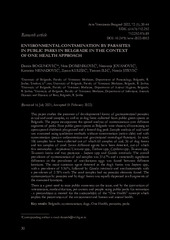Приказ основних података о документу
Environmental contamination by parasites in public parks in Belgrade in the context of one health approach
Kontaminacija životne sredine parazitima u javnim parkovima u kontekstu koncepta jednog zdravlja
| dc.creator | Bogunović, Danica | |
| dc.creator | Dominiković, Nina | |
| dc.creator | Jovanović, Nemanja M. | |
| dc.creator | Nenadović, Katarina | |
| dc.creator | Kulišić, Zoran | |
| dc.creator | Ilić, Tamara | |
| dc.creator | Stević, Nataša | |
| dc.date.accessioned | 2022-05-23T10:50:10Z | |
| dc.date.available | 2022-05-23T10:50:10Z | |
| dc.date.issued | 2022 | |
| dc.identifier.issn | 0567-8315 | |
| dc.identifier.issn | 0567-8315 | |
| dc.identifier.uri | https://vet-erinar.vet.bg.ac.rs/handle/123456789/2460 | |
| dc.description.abstract | This paper studies the presence of developmental forms of gastrointestinal parasites in soil and sand samples, as well as in dog feces collected from public green spaces in Belgrade. The paper incorporates the spread analysis of contamination over different segments of parks. Four public green spaces in Belgrade were chosen, all containing an open-spaced children’s playground and a fenced dog park. Sample analysis of soil/sand was examined using qualitative methods without concentration (native slide) and with concentration (passive sedimentation and gravitational centrifugal flotation). In total, 106 samples have been collected out of which 60 samples of soil, 36 of dog faeces and ten samples of sand. Seven different agents have been detected, out of which five nematodes - Ancylostoma/Uncinaria spp., Trichuris spp., Capillaria spp., Toxocara spp., Toxascaris leonina and two protozoa - Isospora spp. and Giardia intestinalis. The overall prevalence of contamination of soil samples was 31.67% and a statistically significant difference in the prevalence of ancylostoma eggs was found between different locations. The most common agent detected in the dog’s faeces was Isospora spp., with a prevalence of 5.56%, followed by Giardia intestinalis and ancylostomatids with a prevalence of 2.78% each. The sand samples had no parasitic elements found. The contamination by parasites and by dogs’ faeces was equally dispersed in all segments of the examined locations.There is a great need to raise public awareness on the issue, and by the joint action of veterinarians, medical doctors, pet owners and people using public parks for recreation - a precondition is created for the sustainability of the “One Health” concept which implies the preservation of the environment and human and animal health. | |
| dc.language | en | |
| dc.publisher | Faculty of Veterinary Medicine, University of Belgrade | |
| dc.rights | openAccess | |
| dc.rights.uri | https://creativecommons.org/licenses/by/4.0/ | |
| dc.source | Acta Veterinaria | |
| dc.subject | Belgrade | |
| dc.subject | contamination | |
| dc.subject | dogs | |
| dc.subject | One Health | |
| dc.subject | parasites | |
| dc.subject | parks | |
| dc.title | Environmental contamination by parasites in public parks in Belgrade in the context of one health approach | |
| dc.title | Kontaminacija životne sredine parazitima u javnim parkovima u kontekstu koncepta jednog zdravlja | |
| dc.type | article | en |
| dc.rights.license | BY | |
| dc.citation.volume | 72 | |
| dc.citation.issue | 1 | |
| dc.citation.spage | 30 | |
| dc.citation.epage | 44 | |
| dc.citation.rank | M23~ | |
| dc.identifier.wos | 000778291600003 | |
| dc.identifier.doi | 10.2478/acve-2022-0003 | |
| dc.identifier.scopus | 2-s2.0-85128675137 | |
| dc.identifier.fulltext | http://veterinar.vet.bg.ac.rs/bitstream/id/6906/1f90abd33dcdd3a48039c01393351af99481d204_03-Bogunovic.pdf | |
| dc.type.version | publishedVersion |

